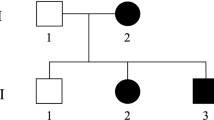Abstract
Hereditary spastic paraplegias are genetically and clinically heterogeneous. Twentysix loci have been identified to date. SPG27 was recently mapped to chromosome 10 in a single family with autosomal recessive hereditary spastic paraplegia (AR–HSP) and a pure phenotype. We describe a Tunisian family with a complicated form of AR–HSP also linked to SPG27. The parents are first cousins and 3 out of their 4 children manifest early onset progressive spastic paraparesis associated with sensorimotor polyneuropathy. In addition, the eldest girl had facial dysmorphism and short stature (–3SD). Two of the three patients were mentally retarded, and one of these also had cerebellar signs. Their ages at onset were 2, 5 and 7 years. A genome–wide scan suggested linkage to SPG27 on the long arm of chromosome 10 with a multipoint lod score of 2.54. In addition, a recombination detected in this family by haplotype reconstruction reduced the SPG27 locus from 25 to 19.6 cM. This is the first clinical description of a complicated form of spastic paraplegia, characterized by great phenotypic variability among the sibs, associated with the SPG27 locus.
Similar content being viewed by others
References
Abdallat A, Davis SM, Farrage J, McDonald WI (1980) Disordered pigmentation spastic paraparesis and peripheral neuropathy in three siblings: a new neurocutaneous syndrome. J Neurol Neurosurg Psychiatry 43:962–966
Bouslam N, Benomar A, Azzedine H, et al. (2005) Mapping of a new form of pure autosomal recessive spastic paraplegia (SPG28) to chromosome 14q. Ann Neurol 57:567–571
Casari G, De Fusco M, Ciarmatori S, et al. (1998) Spastic paraplegia and OXPHOS impairment caused by mutations in paraplegin, a nuclear-encoded mitochondrial metalloprotease. Cell 93:973–983
Cottingham RW Jr, Idury RM, Schaffer AA (1993) Faster sequential genetic linkage computations. Am J Hum Genet 53:252–263
Fink JK (2003) The hereditary spastic paraplegias: nine genes and counting. Arch Neurol 60:1045–1049
Gudbjartsson DF, Jonasson K, Frigge ML, et al. (2000) Allegro, a new computer program for multipoint linkage analysis. Nature Genet 25:12–13
Hentati A, Pericak-Vance MA, Hung WY, et al. (1994) Linkage of ‘pure’ autosomal recessive familial spastic paraplegia to chromosome 8 markers and evidence of genetic locus heterogeneity. Hum Mol Genet 3:1263–1267
Hodgkinson CA, Bohlega S, Abu- Amero SN, et al. (2002) A novel form of autosomal recessive pure hereditary sapstic paraplegia maps to chromosome 13q14. Neurology 59:1905–1909
Meijer IA, Cossette P, Roussel J, et al. (2004) A novel locus for pure recessive hereditary spastic paraplegia maps to 10q22.1–10q24.1. Ann Neurol 56:579–582
Nakamura A, Izumi K, Umehara F, et al. (1995) Familial spastic paraplegia with mental impairment and thin corpus callosum. J Neurol Sci 131:35–42
Scarano V, Mancini P, Criscuolo C, et al. (2005) The R495W mutation in SPG3A causes spastic paraplegia associated with axonal neuropathy. J Neurol (Epub ahead of print)
Seri M, Cusano R, Forabosco P, et al. (1999) Genetic mapping to 10q23.3- q24.2, in a large Italian pedigree, of a new syndrome showing bilateral cataracts, gastroesophageal reflux, and spastic parparesis with amyotrophy. Am J Hum Genet 64:586–593
Slavotinek AM, Pike M, Mills K, Hurst JA (1996) Cataracts,motor system disorder, short stature, learning difficulties, and skeletal abnormalities: a new syndrome? Am J Med Genet 62:42–47
Stewart RM, Tunell G, Ehle A (1981) Familial spastic paraplegia, peroneal neuropathy and crural hypopigmentation: a new neurocutaneous syndrome. Neurology 31:754–757
Vasa G, Zortea M, Boaretto F, et al. (2000) A new locus for autosomal recessive spastic paraplegia associated with mental retardation and distal motor neuropathy, SPG14, maps to chromosome 3q27-q28. Am J Hum Genet 67:504–509
Winner B, Uyanik G, Gross C, et al. (2004) Clinical progression and genetic analysis in hereditary spastic paraplegia with thin corpus callosum in spastic gait gene 11 (SPG11). Arch Neurol 61:117–121
Author information
Authors and Affiliations
Corresponding author
Rights and permissions
About this article
Cite this article
Ribai, P., Stevanin, G., Bouslam, N. et al. A new phenotype linked to SPG27 and refinement of the critical region on chromosome. J Neurol 253, 714–719 (2006). https://doi.org/10.1007/s00415-006-0094-2
Received:
Revised:
Accepted:
Published:
Issue Date:
DOI: https://doi.org/10.1007/s00415-006-0094-2




